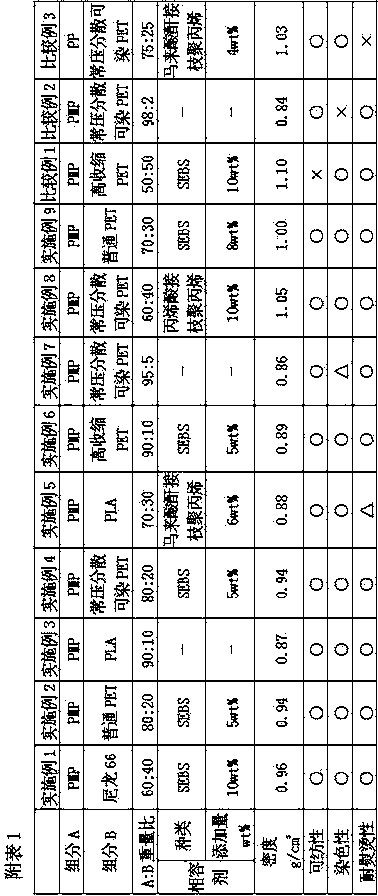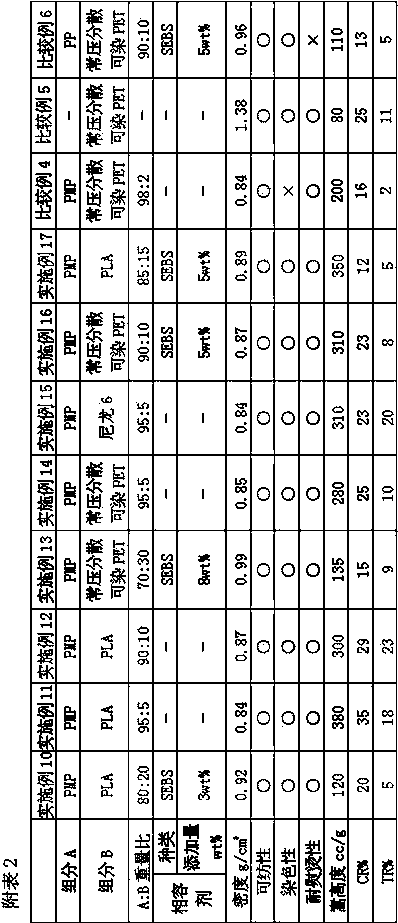Dyeable fiber as well as preparation method and application of dyeable fiber
A fiber and alloy fiber technology, which is applied in the field of dyeable lightweight fiber and its preparation, can solve the problems of non-blending, poor ironing resistance, and decreased fiber strength and elongation, and achieve the effect of good chemical resistance
- Summary
- Abstract
- Description
- Claims
- Application Information
AI Technical Summary
Problems solved by technology
Method used
Image
Examples
Embodiment 1
[0042] Dry PMP (Mitsui Chemicals DX820) and nylon 66 separately, and then blend them at 275°C in a weight ratio of 60:40, then add SEBS compatibilizer equivalent to 10wt% of the total amount of fibers and mix them at 280 Melt spinning at ℃, spraying, oiling and drawing through the spinneret, and unstretched filaments are obtained under the condition of spinning speed of 800m / min; after 1.5 times of thermal drawing, the temperature of 1 hot roller is 100℃ 2. The temperature of the hot rollers is 150° C. to obtain finished fibers. The fibers have good fibrillation / spinnability; the obtained fibers are woven into braids and dyed with acid dyes at a dyeing temperature of 120°C for 60 minutes. The dyeability and ironing resistance are excellent.
Embodiment 2
[0044] Dry PMP (Mitsui Chemicals DX820) and ordinary PET, and then blend them at 280°C at a weight ratio of 80:20, then add SEBS compatibilizer equivalent to 5wt% of the total fiber amount and dry at 290°C Under the condition of melt spinning, it is sprayed out through the spinneret, oiled, drawn, and the unstretched filament is obtained under the condition that the spinning speed is 800m / min; then the unstretched filament obtained is stretched by 1.8 times of heat, wherein 1 The temperature of the hot roller is 100°C, and the temperature of the second hot roller is 130°C to obtain the finished fiber. The fibers have good fibrillation / spinnability; the obtained fibers are woven into braids and dyed with disperse dyes at a temperature of 130°C for 60 minutes. The dyeability and ironing resistance are excellent.
Embodiment 3
[0046] PMP (Mitsui Chemicals DX820) and polylactic acid (PLA) slices were dried separately, then blended at 270°C at a weight ratio of 90:10, and melt-spun at 270°C. Plate ejection, oil supply, extraction, and undrawn yarns are obtained under the condition of spinning speed of 800m / min; then the obtained undrawn yarns are subjected to 2.0 times thermal stretching, wherein the temperature of the first heat roller is 90°C, and the temperature of the second heat roller is 90°C. The roller temperature was 130°C, and the finished fiber was obtained. The fibers have good fibrillation / spinnability; the obtained fibers are woven into braids and dyed with disperse dyes at a dyeing temperature of 120°C for 60 minutes. The dyeability and ironing resistance are excellent.
PUM
| Property | Measurement | Unit |
|---|---|---|
| Density | aaaaa | aaaaa |
| Density | aaaaa | aaaaa |
Abstract
Description
Claims
Application Information
 Login to View More
Login to View More - R&D
- Intellectual Property
- Life Sciences
- Materials
- Tech Scout
- Unparalleled Data Quality
- Higher Quality Content
- 60% Fewer Hallucinations
Browse by: Latest US Patents, China's latest patents, Technical Efficacy Thesaurus, Application Domain, Technology Topic, Popular Technical Reports.
© 2025 PatSnap. All rights reserved.Legal|Privacy policy|Modern Slavery Act Transparency Statement|Sitemap|About US| Contact US: help@patsnap.com


